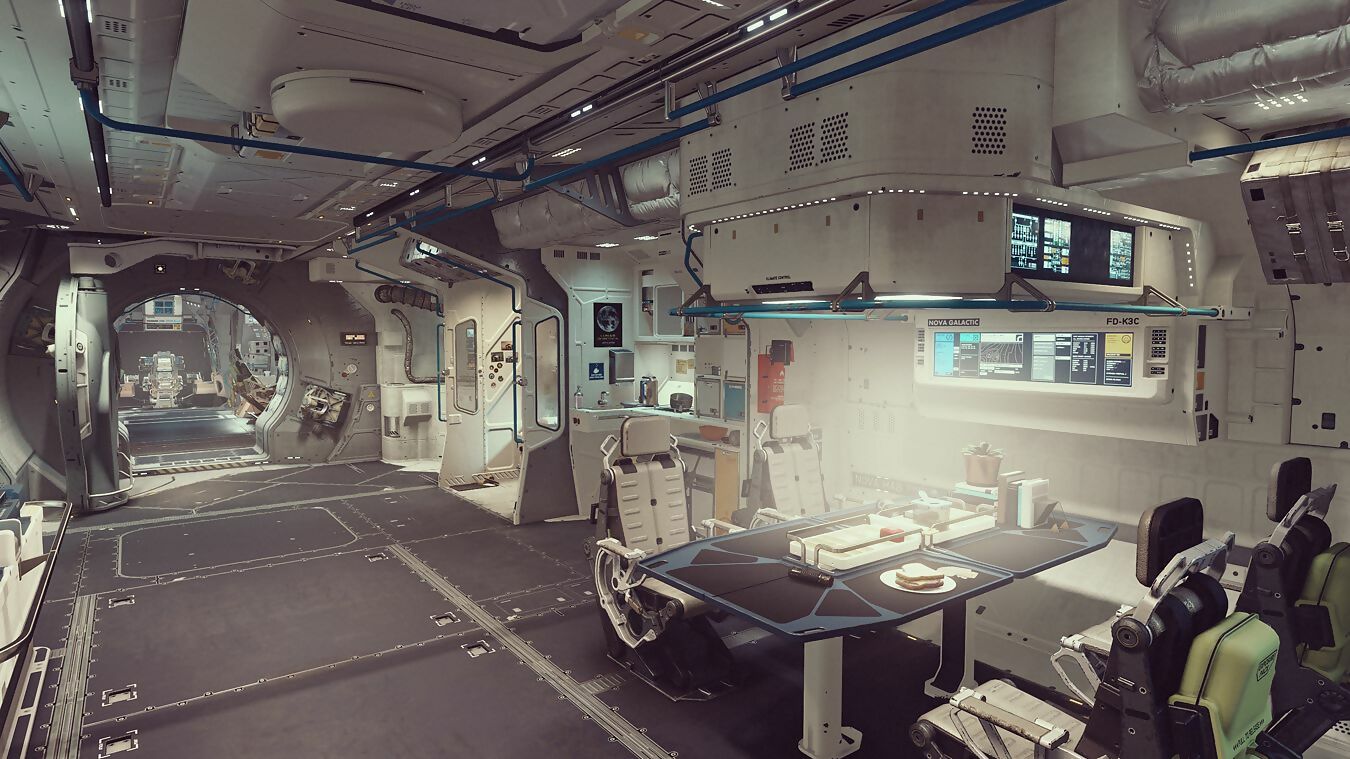
Starfield is the latest in a long line of games to embrace the cassette futurism looks. But as Chris points out, other aesthetics are available.
You wake up on a thin foam mattress in a bunk alcove that isn’t quite shaped like a bed. Groggily, you sit up and look around your space cabin. It’s carpeted with a metal grill, with exposed pipes and wiring running across the wall and ceiling. You get up and make your way to a clunky keyboard in front of a cathode ray tube monitor with a green-on-black display. With the click of a few keys, you order a Fude™Bar and are congratulated on your purchasing choice by a cartoonish but strangely sinister mascot. Like all advertisements, it seems like it wants to be a satire of something, but doesn’t seem entirely clear on what.
Munching on your breakfast, you load a data-VHS of your current assignments onto the CompuUnit. You have options. You could go to the MegaKorp District, with its glistening skyscrapers and heavily armed mall cops, or Crimeopolis, which is very similar except with rain and more neon lights.
However, you expect you’ll probably end up going out to the scattered desert moon outposts of the neo-frontier, to help some grizzled space prospectors, do some fetch quests, or maybe respond to an isolated space laboratory’s distress signal just in time to collect all the dead scientists’ audio logs.
It doesn’t particularly matter what you do. After all, everything’s controlled by the Gigacorporations – the all-seeing, all-powerful mega-companies that vie for control over this laissez-faire space hell.
But while things might be hell in the Capitalistocracy, where else are you going to go? Scrape a living among the Alliance of Independent Planets That Are Totally Not Doing Confederate Cosplay? Or flee into the arms of the Vaguely-Anarcho-Communist Collective?
Maybe it’s cynical of you, but after flying the universe this long you’re starting to suspect all political systems are just the same thinly reskinned quest hubs underneath. Such is the life of an outer space smuggler bounty hunter explorer spacecop in a video game.
As excited as we are to venture out into Starfield’s vast yet fully immersive open-world galaxy, there’s no denying that there are definite recurring elements in the space video game genre that seem a mite overfamiliar.
In Space… Nobody Really Cleans Anything
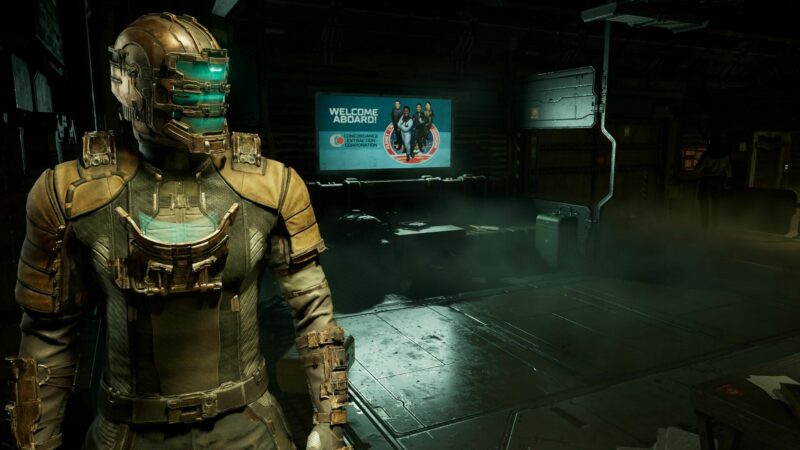
Grimy cassette futurism in Deadspace. Credit: EA.
Starfield has made a big deal out of its much-vaunted “NASA-punk” (or “Cassette Futurism” as others call it), but it’s hard not to regard it with a creeping sense of déjà vu.
Retro technology, clunky, industrial-looking trappings that are a bit on the used side, and a combination of corporate mega capitalism and reskinned Wild West tropes are all things you might recognise from games such as Borderlands, Elite Dangerous, Rebel Outlaw, The Outer Worlds, Dead Space, Freelancer, EVE Online, Star Citizen, Hardspace: Shipbreaker, Void Bastards, Red Faction, Doom, The Gunman Chronicles, System Shock and… feel free to add your own.
It’s not hard to see why these tropes are so popular in space video games. It all comes down to two films of the late seventies – a sword and sorcery romance with sci-fi trappings called Star Wars, and a claustrophobic space horror called Alien.
Read more: Alien | Why the xenomorph is perfect for games, and so hard to get right
They were very different films. One was a wide-eyed tale of swashbuckling adventure, the other was a tale about how capitalism dehumanises, exploits and ultimately disposes of us to fulfil its inhuman purposes. But they shared one quality that seemed astonishing and fresh to cinema audiences of the time.
These films showed us spaceships that were used, old, grimy, places where people lived and worked and didn’t always clean up after themselves. It was an aesthetic that captured an entire generation of creators, and a couple of other generations after that, to the point where that style is ubiquitous not only in games but in pretty much every space-based sci-fi medium you see today.
And a lot of great work has been done within the confines of that aesthetic, there’s no doubt. But as we venture into another retro-industrial-future-wild-west, it’s worth asking “Can outer space be anything else?”
Because the answer is yes! Yes, it can! And here are just some of the alternatives.
Gooey Space
As seen in the games: Scorn, Metroid, Mass Effect, No Man’s Sky
Other media: Farscape, Lexx, Warhammer 40,000’s Tyranids, and of course, Alien
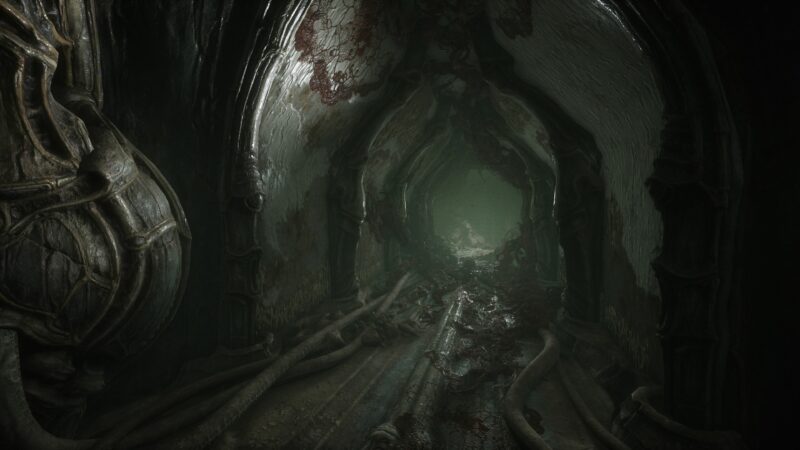
Gooey survival horror in Scorn. Credit: Ebb Software.
We all love Alien, but the Nostromo isn’t the coolest ship in that film (most people still think the Nostromo is the vast, city-sized mining platform being towed through space, rather than the rinky-dink space-tug itself).
The best ship in Alien is the great big HR Giger-designed space doughnut where the title Alien’s eggs are discovered. Of course, HR Giger’s style has become nearly as ubiquitous as the Nostromo’s industrial space retrofuturism. Structures that are unmistakably technological, but summon words to mind like “slick”, and “viscous”, and “genital-esque”. We’re not going to pretend that this aesthetic is a rare thing in video games – the odds are you’ve plasma-gunned a few alien hordes as they swarm down blood-vessel-shaped corridors through ickily sphincter-like doors.
But typically, this look is reserved for the alien hive mind your butch, power-armoured player character has been sent to blow up. Why can’t the biotechnologists be the goodies? What if, instead of commanding a giant metal ship through space, you gently coax your habitable space whale to where you want to be? What if you didn’t just have to keep your ship fuelled, but also happy? No Man’s Sky has dabbled in this with its living ships, but there’s plenty of room for more here.
Outer Space Gothic
As seen in the games: The Banished Vault, Warhammer 40,000: Darktide, and anything else Warhammer 40,000-based
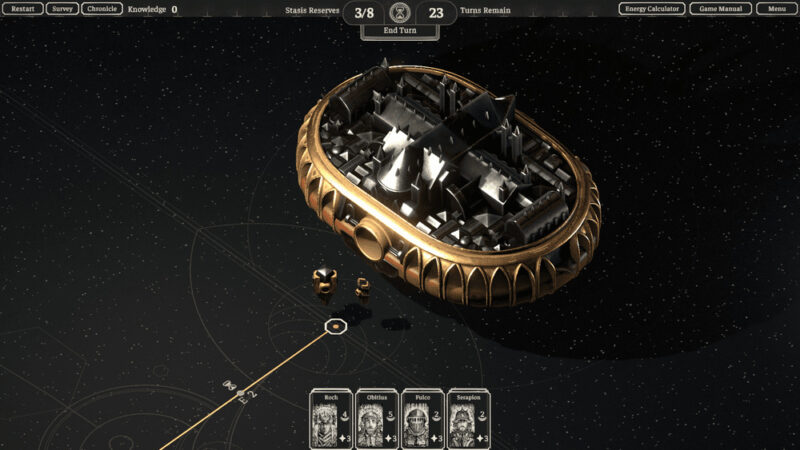
The Banished Vault channelled the gothic aesthetic to memorable effect. Credit: Lunar Division.
As a wise man once said, space is big. There really is no way to get across it quickly without drawing some serious side-eye from theoretical physicists. So the question becomes, when have human beings ever been able to pull together enough to achieve the kind of massive, long-term, multi-generational engineering feat necessary to get even to our nearest star system?
Cathedrals are one of the first examples that come to mind. Whatever else they are monuments to, they are monuments to the ability of people to come together and build something huge intended to last the ages.
We are not the first people to think this.
Nic Tringali and their team of developers on The Banished Vault thought along a similar path.
“The gothic theme of The Banished Vault started with the idea of a generation ship and then asking: ‘What is something we’ve built across generations?’. We landed on the architecture of cathedrals, and how like space they inspire awe and our moment in its time creates introspection,” Tringali tells us. “Gothic cathedrals have a level of detail that is human, but on such a massive scale it’s difficult to fathom that humans built them. From this point, we speculated about a lot of potential histories, including questions like ‘what if the Church listened to Galileo?’, and how these generation-scale ideas would be maintained in an age of space travel.”
This isn’t just about architecture, however. The monastic outlook also offers an alternative to the relentless disaster capitalism we see in most space games. The medieval monasteries of old were economic powerhouses precisely because they held a huge workforce of people willing to live simple, isolated lives carrying out the same acts of service day after day – precisely what you need from a long-term space crew.
But while the parallels are easy to see, as an aesthetic for space travels some may consider it more fanciful than the supposed “realism” of the Nostromo-inspired aesthetic.
For Tringali, this was pretty much the point.
“Much of the gameplay is rooted in mathematics and realistic abstractions of solar systems and spaceflight. We want the player to comprehend how large and uncompromising space travel is, so they can feel triumphant when they overcome it,” they tell us. “When the game focuses on the human experience, we use a more fantastical style because we felt that is a more accurate way to depict the experience of travelling across the galaxy.”
Afrofuturist Space
As seen in the games: We Are the Caretakers
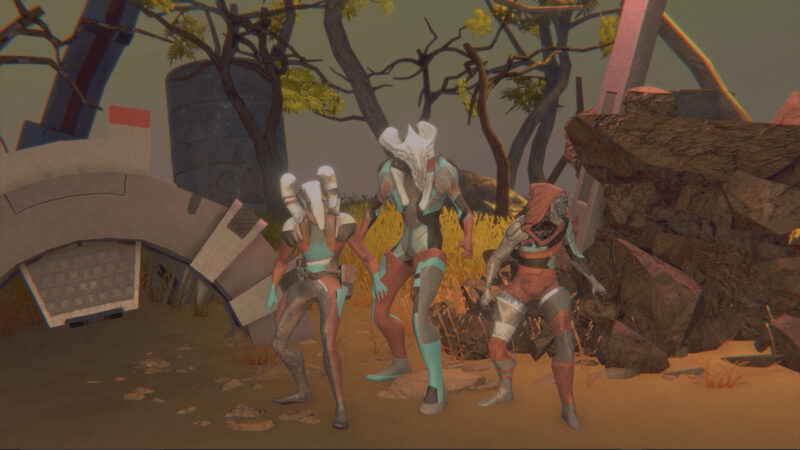
Afrofuturism meets strategy in We Are The Caretakers. Credit: Heart Shaped Games.
Of course, one thing science fiction settings can do to get away from the herd of Star Wars and Alien clones is to not be quite so constantly, unrelentingly Eurocentric in their outlook. Afrofuturism is an aesthetic and philosophy whose roots go back to the middle of the 20th century, and it has received added attention from the mainstream lately thanks to the MCU’s Black Panther movies and the Disney+ animated anthology Kizazi Moto, but these are only the tip of a vast iceberg.
We Are The Caretakers is a squad-based strategy RPG about high-tech gamekeepers protecting their planet’s wildlife when the barrier that separates it from the universe disappears. The Afrofuturist aesthetic is clearly a huge part of the game’s look, but it runs deeper than that.
Xalavier Nelson Jr., the game’s narrative designer, was tasked with defining the kind of Afrofuturist setting We Are The Caretakers would have.
“It was astounding how much one small change – such as the addition and removal of a faction in the ‘desert’ of the game’s setting- impacted the tone of the world we presented,” he tells us.
To create the world of We Are The Caretakers, Nelson and the team at Heart Shaped Games LLC drew from all over.
“The influences on worldbuilding ranged from Billy Joel songs to Game of Thrones,” explains Nelson. “I travelled to Nepal to interview real-life wildlife rangers and conservationists about the lives they led and the lens through which they saw the world, because the grounded influence of outside perspectives kept us from the bland territory of just pulling from Wakanda again, as the most prominent high-budget Afrofuturist work to date.”
Space, The Groovy Frontier
As seen in the games: The Anacrusis, Deathloop
Other media: Logan’s Run, 2001: A Space Odyssey, Star Trek
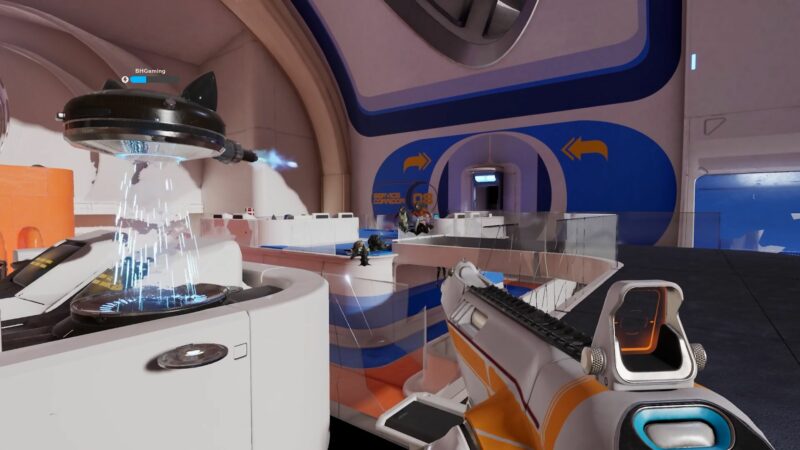
The future looks groovy in The Anacrusis. Credit: Stray Bombay.
The most significant contribution of both Star Wars’ Millennium Falcon and Alien’s Nostromo is that they were dirty, grimy, messy junk heaps. It was a reaction against a post-war, golden age take on space travel where everything was shiny and clean and still had that new Cadillac smell. But now that the new style of spaceships (that look old) has got old, the old style of spaceships (that look new) is new again.
We’re already seeing it on TV, in the sleek, sixties stylings of the sets on Star Trek: Strange New Worlds. This is also why the spaceship interiors of Stray Bombay’s The Anacrusis feel so fresh, by harking back to a pre-Star Wars aesthetic.
As The Anacrusis’s lead developer, Chet Faliszek tells us, “I’m old… so I grew up with early 70s movies and TV shows – we would watch Battlestar Galactica while my parents went to disco lessons – but I always loved that period between Flash Gordon and the Greebles of Star Wars. So, Logan’s Run, 2001: Space Odyssey and Andromeda Strain were really big and all have these really clean simple lines and strong colours.”
Back to the (Retro, Disaster Capitalist, Dystopian) Future
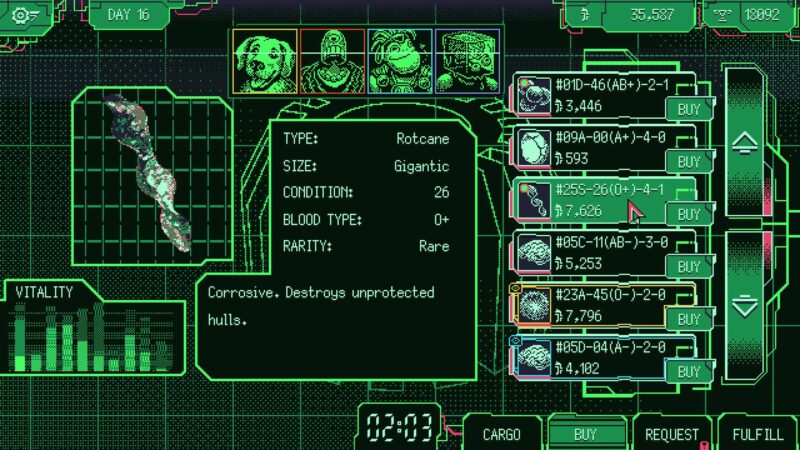
Green screen satire in Space Warlord Organ Trading Simulator. Credit: Strange Scaffold.
But while space settings are by no means restricted to the standard capitalist hellhole setting #4 that most space games, particularly big-budget triple-A productions, seem to opt for, it is also true that there is still untapped potential within that setting. After all, while a satire of giant all-encompassing corporations might seem to lose its teeth if it is published by, say, Microsoft, there is plenty of room for smaller creators who don’t care to pull their punches.
As well as We Are the Caretakers, Xalavier Nelson Jr. has also worked on Space Warlord Organ Trading Simulator, a title that really tells you everything you need to know. The game’s interface is a green-on-black nightmare that would fit right on the Nostromo terminals. But it is also a game that has some things to say.
“When I’m building a new setting, my first port of call is what people believe, and how this manifests itself in the systems they build,” Nelson says. “In Space Warlord Organ Trading Simulator, when you do something altruistic, the interface makes a disappointed beep at you. Economic disasters wipe out the lower and middle classes – while providing players and NPCs at the highest echelons of society to pick up an army of future investments at a discount.”
As satire goes, it is about as subtle as the title Space Warlord Organ Trading Simulator suggests, but as Nelson himself points out, “We ourselves live in an on-the-nose world. We create interfaces and buildings and even arrange our life milestones around the things we truly value… and it’s telling how often this is a departure from what we claim to care about the most. To provide that distinct identity for the virtual world of SWOTS, I just followed the chain of logic and belief, and let that lead me to the dystopian hellscape players have both loved, and found distressingly close to their own lives.”


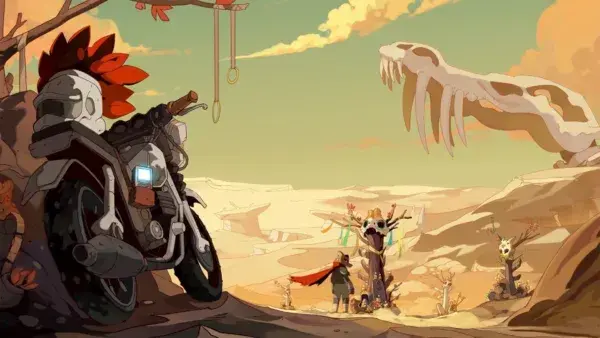

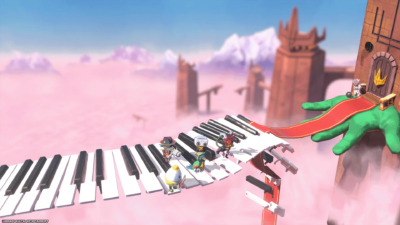
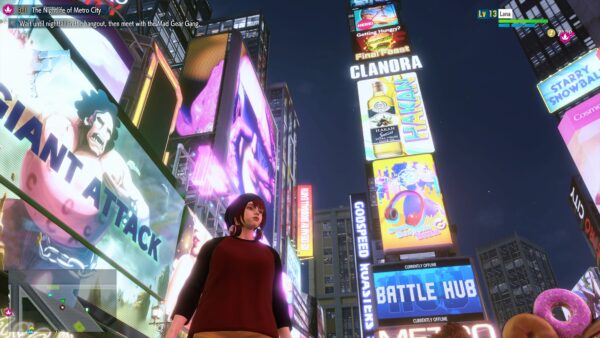
1 Comment
I often sit in the car waiting for my wife to finish work and read an article or two.
This has been the most entertaining and informative one in a while. Thanks!
I like the green on black